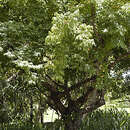Comprehensive Description
provided by North American Flora
Stahlia monosperma (Tul.) Urban, Symb. Ant. 2: 285. 1900
Caesalpinia monosperma Tul. Arch. Mus. Paris 4: 14S. 1844. Stahlia maritima Bello, Anal. Soc. Esp. Hist. Nat. 10: 255. 1881.
A tree, up to 20 m. high, with glabrous twigs and leaves. Petioles 1-2.5 cm. long; leaflets 6-12, mostly opposite, short-stalked, 5-9 cm. long, ovate to ovate-lanceolate, entire or irregularly crenulate, shining above, dull beneath, acute or short-acuminate at the apex, truncate, obtuse or subcordate at the base; racemes 10-15 cm. long, the rachis, bracts, pedicels and calyx sparingly pilose; pedicels stout, recurved, 4-8 mm. long; sepals ovate, obtuse, about 6 mm. long; petals 10-12 mm. long; stamens deflexed, about as long as the petals; legume 5 cm. long or less, about 2.5 cm. wide and 1 cm. thick, purple, coriaceous, 1-seeded.
Type locality: Porto Rico. Distribution: Porto Rico; Vieques.
- bibliographic citation
- Nathaniel Lord Britton and Joseph Nelson Rose. 1928. (ROSALES); MIMOSACEAE. North American flora. vol 23(1). New York Botanical Garden, New York, NY
Physical Description
provided by USDA PLANTS text
Perennial, Trees, Woody throughout, Plants stoloniferous, Stems very short, acaulescent or subacaulescent, Stems erect or ascending, Stems greater than 2 m tall, Stems solid, Stems or young twigs glabrous or sparsely glabrate, Leaves alternate, Leaves petiolate, Stipules inconspicuous, absent, or caducous, Leaves compound, Leaves even pinnate, Leaf or leaflet margins entire, Leaflets opposit e, Leaflets 10-many, Leaves glandular punctate or gland-dotted, Leaves glabrous or nearly so, Inflorescences racemes, Inflorescence axillary, Inflorescence terminal, Bracts very small, absent or caducous, Bracteoles present, Flowers actinomorphic or somewhat irregular, Calyx 5-lobed, Calyx glabrous, Petals separate, Petals orange or yellow, Banner petal ovoid or obovate, Stamens 9-10, Stamens completely free, separate, Filaments hairy, villous, Style terete, Fruit a legume, Fruit unilocular, Fruit tardily or weakly dehiscent, Fruit indehiscent, Fruit orbicular to subglobose, Fruit coriaceous or becoming woody, Fruit exserted from calyx, Fruit glabrous or glabrate, Fruit 1-seeded, Seeds ovoid to rounded in outline, Seed surface smooth, Seeds olive, brown, or black.
Libidibia monosperma: Brief Summary
provided by wikipedia EN
Libidibia monosperma is a species of legume in the family Fabaceae, with the common names cóbana negra and cóbana polisandro. It is found in the Dominican Republic, Puerto Rico, and the United States Virgin Islands. It is a federally listed threatened species of the United States.
- license
- cc-by-sa-3.0
- copyright
- Wikipedia authors and editors

